"Jîna giyan, to namirî, nawit ebête remiz"
Jina, my soul, you will not die. Your name will become a symbol
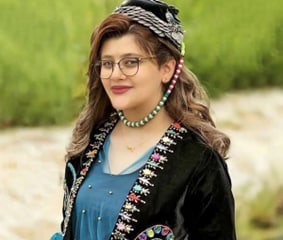
Jina (Mahsa) Amini
September 16, 2024, marks the second anniversary of the killing of 22-year-old Kurdish-Iranian woman Jina (Mahsa) Amini, who was arrested by the Iranian religious police for wearing her headscarf "improperly" and died in police custody. Her killing sparked protests all over Iran as she became the symbol of the uprising against the Iranian regime.
A few days before Jina became a national emblem, her family engraved the following words on her gravestone: "Jîna giyan, to namirî, nawit ebête remiz [Jina, my soul, you will not die. Your name will become a symbol]."
Yet Jina was arrested, tortured, and murdered not only because she was wearing her hijab too "loosely" but also because she was Kurdish. Kurdish-Swedish activist Dr. Kochar Walladbegi wrote: "In Iran... minorities such as the Kurds are being suppressed... For Kurds, being killed and tortured is a systematic behavior [of the Islamic Republic], they face this every day of their lives!... Jina was tortured by the Iranian morality police... also because she was a Kurd and a woman, which makes her a minority within a minority! I decided to call her by her Kurdish name Jina that stand for living, a name she, like many other Kurds, was not allowed to carry. Instead, she was forced to carry 'Mahsa' as her official name, for the short 22 years of her life."[1]
In fact, in Iran, a way to oppress the Kurdish minority and erase their identity is to ban Kurdish names. "Iran denies names that are not on their approved Persian and Islamic list, names that represent ethnic nationalism or regional pride are banned, with the exception of Persian names," Kurdish affairs commentator Himdad Mustafa explained.[2] Therefore, in her official documents, Jina was registered as "Mahsa," a Persian name permitted by the Islamic Republic. At home, she was Jina. This is the name her family called her; this is the name her mother uttered as she wept upon her grave.
Hence, the protests against the Iranian regime that followed her death can be defined not only as a women-led uprising, but also an ethnic minorities-led one. In fact, for the ethnic minorities that comprise almost half of Iran's population (e.g., Ahwazi Arabs, Kurds, and Balochis), this is a "revolution" for liberty and basic ethnic and human rights, of which they have been deprived not only by the Islamic Republic of Iran, but also by the former Persian regimes (e.g., under the Pahlavi dynasty) for almost a century.
It is worth noting that the protests' Farsi slogan "Zan, Zendegi, Azadi [Woman, Life, Freedom]" is a popular Kurdish one, "Jin, Jiyan, Azadi," which has been used for years by the Kurdish independence movement. Explaining the meaning of the slogan in her book The Art Of Freedom, Kurdish freedom movement activist Havin Guneser stated: "We say women's revolution liberates life. In Kurdish, the root of the word life is Jin. Jin means woman, while jîn means alive and jiyan means life. The root word is the same. And that is why we say Jin, Jiyan, Azadi. Azadi means freedom. And given that the Sumerian word for freedom is Amargi, which means 'returning to the mother,' the three words are so interconnected and make perfect sense: women, life, freedom. As women become free, it is inevitable that life itself return to its magic and enchantment. Thus, the slogan Jin, Jiyan, Azadi."[3]
The killing of Jina inspired the whole country to unite and rebel against dictatorship. Demonstrations have been held in all regions of Iran, despite the brutal crackdown on protesters. Hundreds of people were killed during the riots by the Basij, dozens were executed, and many are still in prison awaiting execution. Even though the world's attention to the Iranian uprising has dissipated, the "revolution" against the Islamic republic lives on, and the regime fear that the anniversary of Jina's killing could ignite new protests in the country.
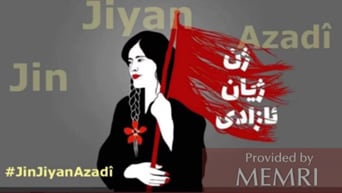
The Kurdish slogan "Jin, Jiyan, Azadi [Woman, Life, Freedom]" (Source: Twitter).
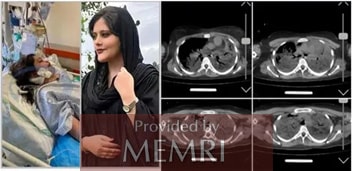
Jina Amini and CT scans published by hackers who obtained them from the hospital in which she died (Source: Iranintl.com, September 19, 2022).
The following is a selection of the main MEMRI reports published in the past year on the revolution in Iran against the Islamic regime.
The Killing Of Jina (Mahsa) Amini
-
MEMRI Daily Brief No. 420, Give Her Back Her Kurdish Name: Jina Amini, By Anna Mahjar-Barducci, October 10, 2022.
-
MEMRI Daily Brief No. 425, 40 Days Without Jina - The Revolution Continues In Her Name, By Himdad Mustafa, October 26, 2022
-
MEMRI TV Clip No. 9837, Protesters In Iran Mark 40 Days Since The Death Of Jina (Mahsa) Amini During Arrest By Iran's Morality Police: We Will Overthrow Khamenei And Avenge Jina! October 26, 2022.
-
Special Dispatch No. 10229, Iranian Majles Member And Fmr. Health Minister Masoud Pezeshkian Blames Regime For Mahsa Amini's Death: Our Behavior Is Making Iranians Hate Islam, We Must Reexamine Our Methods; You Cannot Implement Faith With Force, September 26, 2022.
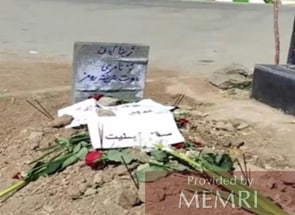
Jina Amini's grave (Twitter.com)
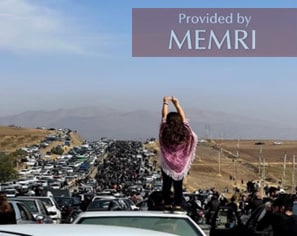
The 40th day after the state murder of Jina (Source: Facebook)
The Revolt In Iran Is An Ethnic Minorities-Led Uprising
-
MEMRI Daily Brief No. 423, The Revolt In Iran Is An Ethnic Minorities-Led Uprising, By Himdad Mustafa, October 25, 2022.
-
MEMRI Daily Brief No. 428, The Islamic Republic Of Iran Will Collapse Only If Its Ethnic Minorities Are Supported, By Himdad Mustafa, November 11, 2022.
-
MEMRI Daily Brief No. 426, A Roadmap Towards Confederalism For The Future Of Iran, By Himdad Mustafa, November 3, 2022.
-
MEMRI Daily Brief No. 449, The Uprising Of The 'Multinational Iran', By Himdad Mustafa, January 17, 2023.
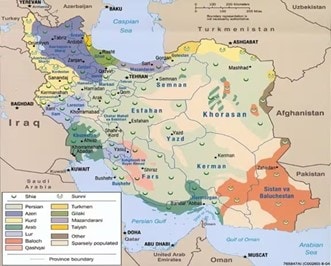
Map of Iran (Source: CIA)
Uprising Against The Regime
Anti-Regime Protests
-
MEMRI TV Clip No. 9837, Violent Clashes, Protests Continue In Iran After Death Of Woman At Hands Of Morality Police For 'Improperly' Wearing Her Headscarf: Be Wary Of The Day When We Have Weapons! Khamenei, We Will Bury You! Death To The Islamic Republic! Death To The Dictator! September 19, 2022.
-
MEMRI TV Clip No. 9891, Over One Month After Jina (Mahsa) Amini's Death, Protests Continue In Iran – Molotov Cocktails Thrown At Official Buildings, Protestors Chant: We Will Fight, We Will Die, We Will Take Iran Back! October 24, 2022.
-
MEMRI TV Clip No. 9911, Widespread Anti-Regime Protests In Iran Continue: Basiji, IRGC, You Are Our ISIS! We'll Give Our Lives For Freedom In Iran!, October 29, 2022.
-
MEMRI TV Clip No. 9940, Iranian Protesters Light Bonfires, Torch Public Buildings, Monuments, Posters Of Khamenei: Death To Khamenei! The End Is Near For The Basij! This Is The Year Of The Bloody Uprising! November 17, 2022.
-
Inquiry & Analysis No. 1678, The 2022 World Cup In Qatar – An Additional Arena For Iranian Protests Against The Islamic Regime, By N. Katirachi and A. Savyon, January 12, 2023.
-
MEMRI TV Clip No. 10176, Anti-Regime Protests Throughout Iran During Traditional Fire Festival Of Chaharshanbe Suri: Khamenei Will Be Toppled! This Is The Year Of Bloody Uprising! March 14, 2023.
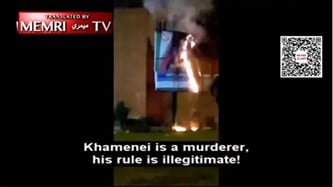
(Source: MEMRI)
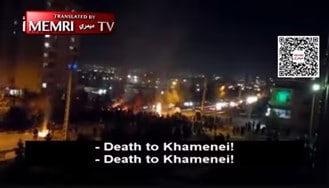
(Source: MEMRI)
Protestors Attacking the Symbols Of The Regime
-
MEMRI TV Clip No. 9922, Iranian Protestors Knocking Turbans Off The Heads Of Islamic Scholars, November 10, 2022.
-
Special Dispatch No. 10304, Iranian Protestors Deface Posters, Statues Of Qasem Soleimani, Shout: Death To Khamenei! November 7, 2022.
-
MEMRI TV Clip No. 10030, Iranian Protestors Mark Third Anniversary Of Qasem Soleimani's Killing By Defacing Posters And Statues Of Him: Death To The Dictator! The Revolution Of 2022 Will Not Falter! January 3, 2023.

Iranian Protestors Knocking Turbans Off The Heads Of Islamic Scholars. (Source: Iranintl.com)
Demanding Rights For Kurdistan
-
MEMRI Daily Brief No. 421, Sanandaj Leads The Battle For Freedom – The 'Leningrad' Of Eastern Kurdistan Is Besieged By The Islamic Republic Of Iran, By Arif Bawecani and Anna Mahjar-Barducci, October 14, 2022.
-
Special Dispatch No. 10295, Male And Female Students At The University Of Kurdistan In Sanandaj, Iran Dance Together And Chant: Woman, Life, Freedom! In Protest Against The Regime, November 2, 2022.
-
MEMRI TV Clip No. 9972, Kurdish Iranian Majles Member Jalal Mahmoudzadeh: I Hold Interior Minister Vahidi Accountable For The Killing Of Protesters In Kurdish Areas; Why Doesn't He Stop The Crackdown On Kurdish Towns? November 28, 2022.
-
MEMRI TV Clip No. 10112, Female Fighters Of The Kurdish Opposition To Iranian Regime Train In Camps In Iraqi Kurdistan: We Participated In The Demonstrations But Had To Leave Iran Due To Security Forces Crackdown, February 5, 2023.
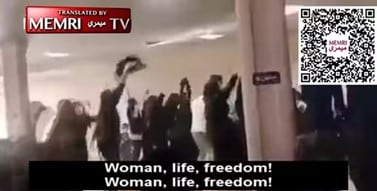
Male And Female Students At The University Of Kurdistan In Sanandaj (Source: MEMRI)
Demanding Rights For Balochistan
-
MEMRI TV Clip No. 9927, Anti-Regime Protests In Iran's Baluchestan Province: Free Baluchestan! The Kurds Are Not Alone! Curse The Rule Of The Jurisprudent! Death To Basiji! November 11, 2022.
-
MEMRI Daily Brief No. 436, Balochistan Is A Strategic Outpost For Countering The Islamic Republic Of Iran, By Rudam Azad, December 6, 2022.
-
MEMRI Daily Brief No. 438, The Islamic Republic Of Iran's 'Slow Motion' Genocide Of The Balochi People, December 15, 2022.
-
MEMRI TV Clip No. 10058, WARNING – GRAPHIC: Iranian Regime Violently Cracks Down On Protesters In Baluchestan; Protestors Chant: Death To Khamenei! Death To The IRGC! January 13, 2023.
-
MEMRI Daily Brief No. 457, Iran's Security Services Target Baloch Women, By Rudam Azad, February 16, 2023.
-
MEMRI TV Clip No. 10079, Protesters In Zahedan, Iran: Death To Khamenei! Khamenei — Have Some Honor And Leave The Country! This Is The Year Of Bloody Uprising! January 20, 2023.
-
MEMRI TV Clip No. 10102, WARNING — GRAPHIC: Anti-Regime Demonstrations In Baluchestan, Iran; Regime Security Opens Fire On Demonstrators, Arrest Citizens, Publicly Flog Man, February 3, 2023.
-
MEMRI TV Clip No. 10269, Iranian TV Report About Violent Crackdown On Protesters Who Stormed Zahedan Police, April 28, 2023.
-
MEMRI TV Clip No. 10218, Iranian Shiites Visit Sunni Mosque In Baluchestan: We Were Not Forced To Wear The Hijab At The Mosque; The People Here Do Not Deserve What Is Happening To Them, March 28, 2023.
-
MEMRI TV Clip No. 10160, Weekly Protests Continue In Baluchestan, Iran: Death To Khamenei! We Will Not Waver! March 3, 2023.
-
MEMRI TV Clip No. 10127, At Weekly Anti-Regime Protests In Iran's Baluchestan, Demonstrators Demand Freedom For Political Prisoners, Chant: Death To Khamenei! Death To The IRGC! The People Want The Leadership Of Sunni Spiritual Leader Molavi Abdolhamid! February 17, 2023.
-
MEMRI TV Clip No. 10125, Iranian Regime Shoots Hundreds Of Donkeys Used By Residents Of Sistan And Baluchistan For Fuel Trade Across Pakistan Border, February 18, 2023.
-
MEMRI TV Clip No. 10185, Anti-Regime Protests In Baluchestan, Iran: I Will Kill Whoever Killed My Brother! We Swear On The Blood Of Our Comrades That We Will Not Waver! March 17, 2023.
-
MEMRI TV Clip No. 10210, Anti-Regime Protests in Baluchestan, Iranian Forces Shoot Oil Traders, Protestors Chant: Death to IRGC! Death to Basij! We Will Not Accept Indignity! March 31, 2023.
-
MEMRI TV Clip No. 10281, Weekly Anti-Regime Protests In Baluchistan, Iran: We Swear On The Blood Of Our Comrades That We Will Not Waver! May 5, 2023
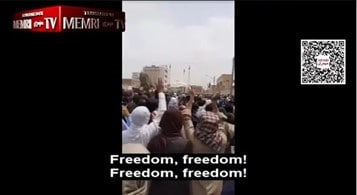
(Source: MEMRI)
Main Opposition Figures Against The Islamic Republic
Sunni Leader Molavi Abdolhamid
-
Special Dispatch No. 10366, In Zahedan, Iran Friday Sermon, Sunni Spiritual Leader Molavi Abdolhamid Demands Accountability For Victims Killed During Crackdown On Protesters, Adds: Where Criticism Is Prevented, Tyranny Is Created; Truth Must Always Be Followed, Even When Uttered By Americans And Israelis, December 8, 2022.
-
MEMRI Daily Brief No. 456, Who Is Iran's Anti-Regime Sunni-Baloch Leader Molavi Abdolhamid? By Suzan Quitaz, February 13, 2023.
-
Special Dispatch No. 10451, Iranian Sunni Spiritual Leader Molavi Abdolhamid In Friday Sermon In Iran's Baluchestan: Iranians Want A Peace-Seeking Country, Not A Warmongering One; Israelis Deserve An Independent State, Just Like The Palestinians, February 3, 2023.
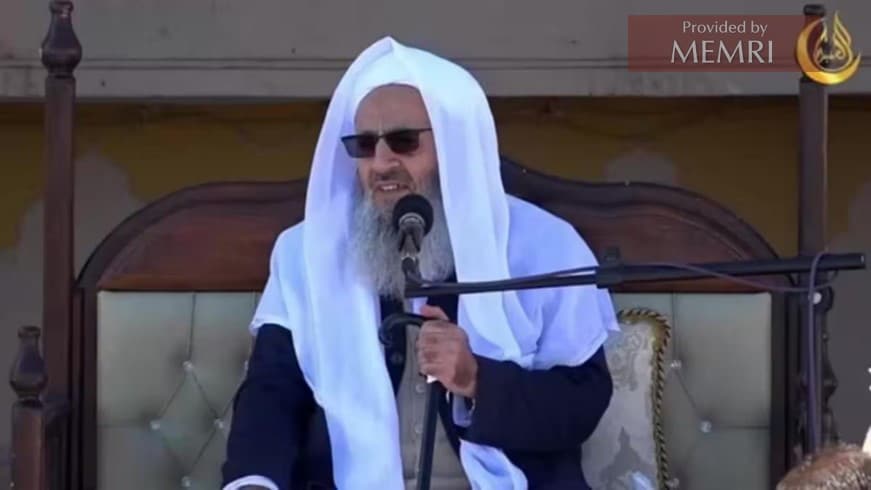
Sunni-Baloch Leader Molavi Abdolhamid (Source: MEMRI)
Hamed Esmaeilion
-
Special Dispatch No. 10070, Iranian-Canadian Activist Hamed Esmaeilion At Ceremony Commemorating Ukrainian Flight Downed By The IRGC: We Live For A Day Without The Islamic Republic And Without The Criminals Who Ruin Beautiful Iran, January 8, 2023.
-
MEMRI Daily Brief No. 460, Hamed Esmaeilion: The Moral Compass Of The Iranian Opposition, February 27, 2023.
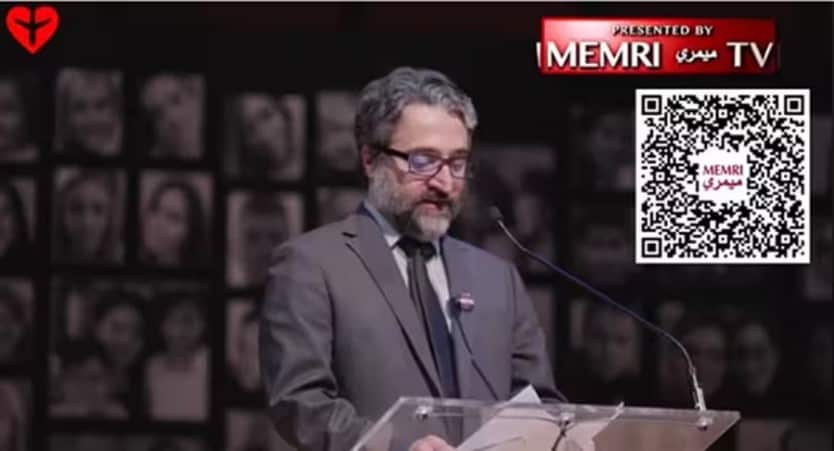
Hamed Esmaeilion (Source: MEMRI)
Hussein Yazdanpana
-
MEMRI Daily Brief No. 468, Hussein Yazdanpana – The Kurdish Leader Calling For The Toppling Of The Islamic Republic Of Iran, By Suzan Quitaz, March 16, 2023.

Hussein Yazdanpana (Source: Twitter)
Iranian Human Rights Activist And Khamenei's Niece Farideh Moradkhani
-
MEMRI TV Clip No. 9955, Iranian Human Rights Activist, Khamenei's Niece Farideh Moradkhani: Iranian People Are Fighting A Murderous, Child-Killing Regime; Anti-Iran Sanctions Are Ridiculous; Khomeini, Khamenei Are Like Hitler, Mussolini, November 26, 2022.
Hyrbyair Marri
-
MEMRI Daily Brief No. 483, Renowned Baloch Leader Hyrbyair Marri: A Nuclear Deal With Iran Is A Deal With The Devil, May 22, 2023.
Iranian Monarchists Do Not Represent The "Multinational Iran"
-
MEMRI Daily Brief No. 452, The Iranian Monarchists Do Not Represent The 'Multinational Iran', By Himdad Mustafa, January 30, 2023.
-
MEMRI Daily Brief No. 486, Iranian Monarchists Are To Blame For The Failure Of The Opposition, By Himdad Mustafa, May 30, 2023.

(Source: MEMRI)
Women's Status And Iran's Hijab War
-
Inquiry & Analysis No. 1786, The Iranian Regime Continues To Violently Enforce The Hijab On Women – Despite The Public's Protests, By A. Savyon and N. Katirachi, September 6, 2024
-
MEMRI Tv Clip No. 11344, Women In Iran Being Violently Arrested, Assaulted For Not Wearing The Hijab Properly, May 14, 2024
-
Inquiry & Analysis No. 1756, The Women's Protest In Iran 2022-23 – Part II: A Year After The Iranian Regime's Crackdown, It Continues To Force The Hijab On Women, By A. Savyon and N. Katirachi, April 1, 2024
-
Inquiry & Analysis No. 1718, The Women's Protest In Iran 2022-23 – Part I: Women's Status In Revolutionary Iran According To Iranian Supreme Leader Khamenei, By N. Katirachi and A. Savyon, September 14, 2023
-
MEMRI Daily Brief No. 422, Enforcing The Headscarf Is Not A Matter Of Cultural Choice – It Is An Attack Against Women, October 20, 2022.
-
Inquiry & Analysis No. 1654, Iran's Hijab War – An Expression Of The Struggle For Political Freedom: Part I, October 3, 2022.
-
Inquiry & Analysis No. 1655, Iran's Hijab War – An Expression Of The Struggle For Political Freedom: Part II, October 7, 2022.
-
MEMRI Daily Brief No. 416, By Removing The Hijab, Iranian Women Are Depriving The Islamic Republic Of Its Most Powerful Political Tool, October 2, 2022.
-
MEMRI TV Clip No. 10262, Iranian Official Public Announcement On Hijab Enforcement: If A Woman Is Caught Without Her Hijab Inside A Car, It May Be Impounded, April 17, 2023.
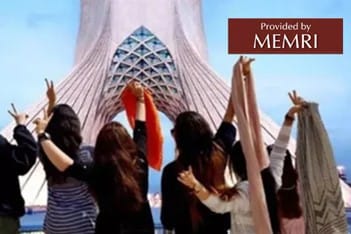
(Source: Twitter)
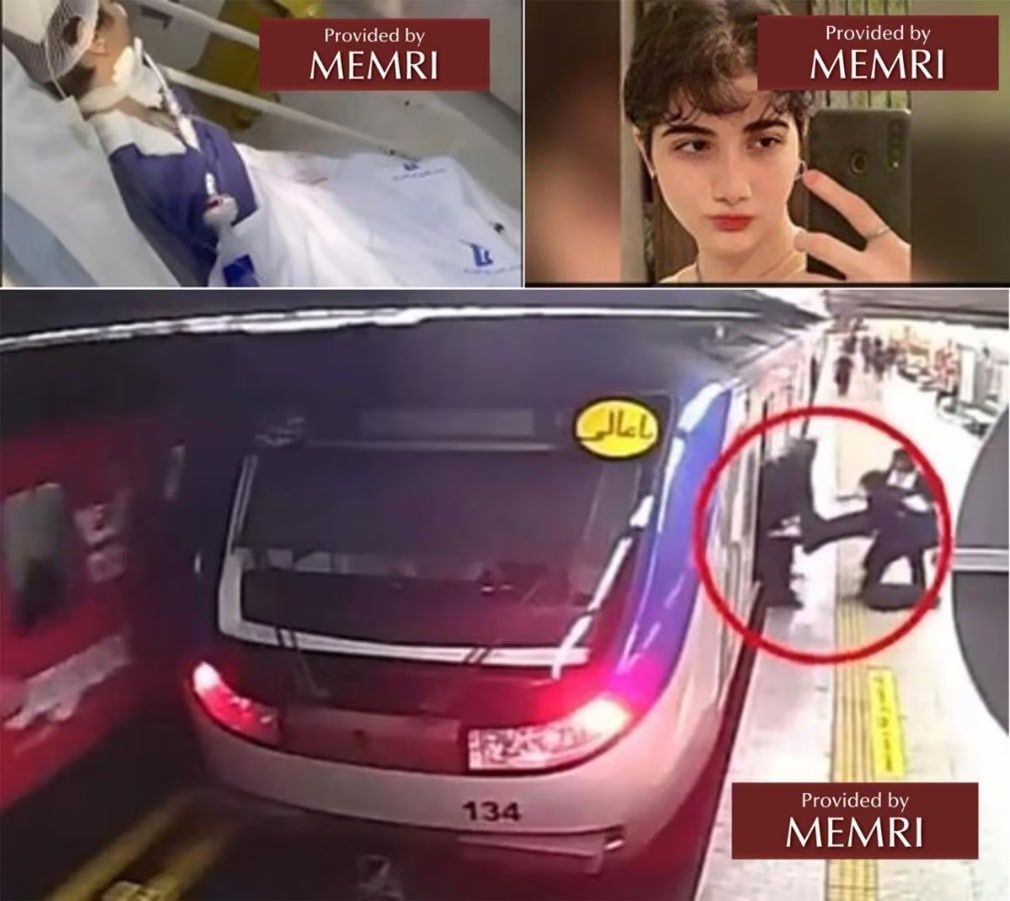
Top: Anita Garavand, the Kurdish-Iranian teenager who was in a coma and subsequently died after she was violently confronted by Iranian authorities for failure to wear the hijab in public. Bottom: Footage of the incident. Source: Iran International, October 2023.
Anti-Regime Songs
-
MEMRI TV Clip No. 9876, Viral Song Based On Iranian Protestors' Anti-Regime Tweets: For The Sake Of Woman, Life, Freedom! September 29, 2022.
-
MEMRI TV Clip No. 9878, Mashup Of Songs Associated With Iranian, Cuban Protests: No More Lies, We Want Freedom! October 19, 2022.
-
MEMRI TV Clip No. 9935, Iranian Sisters Samin And Behin Bolouri's Persian Version Of "Bella Ciao" Gains Immense Popularity Against The Backdrop Of Popular Protests In Iran: The Chains Of Oppression Will Be Broken By Our Hands! November 16, 2022.
-
MEMRI TV Clip No. 9991, Iranian Artist Morteza Ghaderi Performs Dance Routine Across From Tehran's Azadi Tower To Song Dedicated To Jina (Mahsa) Amini, Calling For Execution Of 'Insolent' Iranian Officers, November 11, 2022.
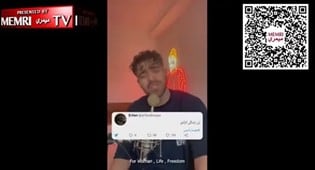
Iranian singer and songwriter Shervin Hajipour singing "Baraye" ("For the sake of"), which is based on anti-regime tweets, went viral on social media, and became an anthem for protesters against the Islamic Republic. (Source: MEMRI)
Crackdown On Protestors, Executions, And Political Prisoners
Crackdown on Protestors
-
MEMRI TV Clip No. 9857, Iranian Political Activist Saeed Shariati On Iran TV: We Live In A Totalitarian Regime Like North Korea; Our Officials Must Reconsider Their Crackdown On Protestors; People Are Protesting Because They Have No Voice, September 20, 2022.
-
MEMRI TV Clip No. 9952, Warning — GRAPHIC: Iranian Authorities Violently Crack Down On Anti-Regime Protestors Throughout Iran, Use Heavy Machine Guns, November 15, 2022.
-
MEMRI TV Clip No. 10076, Iranian Regime Cracks Down On Anti-Regime Protests: Military Vehicle Runs Over Protester, IRGC Personnel Open Fire On Students; Protesters Chant: "Death To Khamenei!" January 21, 2023.
-
MEMRI TV Clip No. 10039, Fmr. Iranian President Ahmadinejad: The Regime Should Listen To The People, Who Are Unhappy With How The Country Is Being Run; Stop Oppressing The People; Make A Change Before It Is Too Late, November 18, 2022
-
Inquiry & Analysis No. 1674, Antiregime Protests By Women, Ethnic Minorities, And Students In Iran – Part I: The Protestors' 'Woman, Life, Freedom' Chant vs Islamic Regime Claims That The Protests Are Organized By Foreign Countries, December 23, 2022.
-
Inquiry & Analysis No. 1679, Antiregime Protests By Women, Ethnic Minorities, And Students In Iran – Part II: Criticism Of How The Regime Is Suppressing The Protests, By A. Savyon and M. Manzour, January 19, 2023.
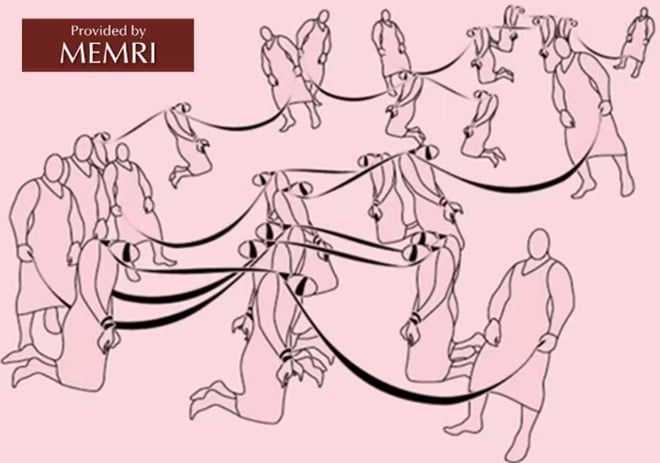
Parastou Forouhar (Source: Toosfoundation.com/parastou-forouhar/)
Death Sentences
-
MEMRI TV Clip No. 9993, Iranian TV Airs 'Confession' Of Protestor Majid-Reza Rahnavard, Executed On December 12 For 'Rebellion Against God', December 13, 2022.
-
MEMRI TV Clip No. 9981, Mother Of Saman Seydi, Iranian Kurdish Rapper Sentenced To Death By Regime For Participation In Protests, Pleads For Help To Prevent His Execution: I Ask The People, Human Rights Organizations To Help My Son, December 1, 2022.
-
MEMRI TV Clip No. 9980, Footage: The Family Of Mohsen Shakeri, A 23-Year-Old Iranian Protester, Upon Receiving The News Of His Execution By The Regime, December 8, 2022.
-
Special Dispatch No. 10379, Iranian Regime Escalates Its Suppression Of Unrest In The Country: IRGC-Affiliated 'Javan' Daily Warns That 60 Or More Protestors Will Be Executed, December 14, 2022.
-
MEMRI TV Clip No. 9994, Iranians Protest Against Regime's Recent Executions Of Demonstrators: If You Execute, There Will Be An Uprising! December 11, 2022.
-
Inquiry & Analysis No. 1672, Compassionate Doctor Sentenced To Death In Iran, By Anna Mahjar-Barducci and R. Sosnow, December 16, 2022.
-
MEMRI TV Clip No. 10013, Parents Of Iranian Prisoners At Risk Of Execution Plead For Their Release; Mother Of Blogger Sattar Beheshti, Killed By Regime: May You Mourn The Death Of Khamenei's Son, December 8, 2022.
-
Inquiry & Analysis No. 1673, In Iran, Kurdish Rapper Sentenced To Death Based On False Evidence, December 20, 2022.
-
MEMRI Daily Brief No. 447, The Execution Of Kurds By The Islamic Republic Of Iran, By Himdad Mustafa, January 12, 2023.
-
MEMRI TV Clip No. 10045, Iranians Protest Against Impending Executions Of Mohammad Ghobadlou And Mohammad Boroughani: There Will Be An Uprising If You Carry Out The Executions! This Is The Year Of Bloody Uprising, Khamenei Will Be Toppled! January 8, 2023.
-
MEMRI TV Clip No. 10059, Iranian Rapper Toomaj Salehi, Imprisoned And In Immediate Risk Of Execution For Participating In Anti-Regime Protests, In Music Video Titled 'Survivor': I'm The Wrath Of God; Iran Is Mine, It's Totally Wrecked, But I Will Rebuild It Myself! November 26, 2022.

(Source: MEMRI)
The West's Role
-
MEMRI Daily Brief No. 413, The West's Fatal Attraction To The Islamic Republic Of Iran, By Anna Mahjar-Barducci, September 23, 2022.
-
MEMRI Daily Brief No. 414, If Iranians Want Change, They Will Have To Do It On Their Own – The West Will Not Help, By Anna Mahjar-Barducci, September 26, 2022.
Iranian Regime Officials' Statements On The Uprising
-
Special Dispatch No. 10338, Iranian Supreme Leader Ali Khamenei: All U.S. Presidents Have Fought Iran; Some Have Dropped Dead And Some Are Still Alive, Like Poor, Demented Biden Who Wants To Save Iran And The Iranians, November 23, 2022.
-
Special Dispatch No. 10335, Iranian Official Abbas Haji Najjari: The Arrogant Western Powers Are Behind The Riots In Iran; We Can Target Israel's Sensitive Facilities, Including The Dimona Reactor; U.S. Withdrew From Afghanistan, Iraq In Fear Of Iran, November 23, 2022.
-
MEMRI TV Clip No. 9990, Iranian Ambassador To Lebanon Mojtaba Amani: The Death Of Jina (Mahsa) Amini Was Normal, Could Happen Anywhere; Hostile Media 'Armies' Are Using This As A Pretext To Incite Protests, December 8, 2022.
-
MEMRI TV Clip No. 9986, Spokesman Of Iran's Judiciary, Masoud Setayeshi, Justifies Execution Of Protester Mohsen Shakeri: Everything Was Done In Keeping With The Law; His Actions Constituted 'Rebellion Against God,' December 10, 2022.
-
MEMRI TV Clip No. 10008, Tehran Friday Sermon By Senior Iranian Official Ayatollah Ahmad Khatami: The Anti-Regime Protesters Want The Freedom To Have Obscenity, But Real Freedom Is In The Islamic Regime – American Freedom Is Actually Slavery, December 16, 2022.
Divisions Inside The Iranian Establishment
-
MEMRI Daily Brief No. 430, The Struggle Among The Political Elite Of The Islamic Republic Of Iran, By Himdad Mustafa, November 16, 2022.
[1] See MEMRI Daily Brief No. 420, Give Her Back Her Kurdish Name: Jina Amini, By Anna Mahjar-Barducci, October 10, 2022.
[2] See MEMRI Daily Brief No. 420, Give Her Back Her Kurdish Name: Jina Amini, By Anna Mahjar-Barducci, October 10, 2022.
[3] See MEMRI Daily Brief No. 420, Give Her Back Her Kurdish Name: Jina Amini, By Anna Mahjar-Barducci, October 10, 2022.




